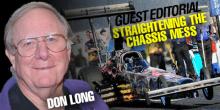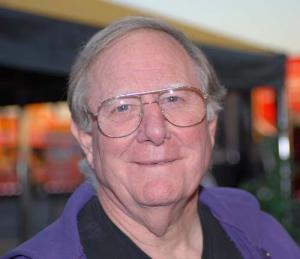GUEST EDITORIAL WITH DON LONG - "IT’S TIME TO STRAIGHTEN OUT THIS CHASSIS MESS"
 My name is Don Long. For
more than five decades I’ve designed and built Top Fuel dragsters, cars that
have won more races than I can count, along with numerous championships and
builder’s awards that I’m very proud of.
But, the thing I’m most proud of is my chassis safety record, which is
perfect.
My name is Don Long. For
more than five decades I’ve designed and built Top Fuel dragsters, cars that
have won more races than I can count, along with numerous championships and
builder’s awards that I’m very proud of.
But, the thing I’m most proud of is my chassis safety record, which is
perfect.
I’ve been actively involved with SFI since it first came into
existence. I was the senior member of
the former (disbanded June 7, 2006) SFI Chassis Committee. There’s been enough written about the SFI in
recent months for it to be unnecessary for me to explain what it is and what
it’s supposed to do.
For those of you having difficulty understanding – and even coherently reading – the recent SFI Top Fuel Chassis Spec, please be assured that it’s not you. This spec has become almost completely incomprehensible on both the scientific and interpretive levels due to a number of factors.
 My name is Don Long. For
more than five decades I’ve designed and built Top Fuel dragsters, cars that
have won more races than I can count, along with numerous championships and
builder’s awards that I’m very proud of.
But, the thing I’m most proud of is my chassis safety record, which is
perfect.
My name is Don Long. For
more than five decades I’ve designed and built Top Fuel dragsters, cars that
have won more races than I can count, along with numerous championships and
builder’s awards that I’m very proud of.
But, the thing I’m most proud of is my chassis safety record, which is
perfect.
I’ve been actively involved with SFI since it first came into
existence. I was the senior member of
the former (disbanded June 7, 2006) SFI Chassis Committee. There’s been enough written about the SFI in
recent months for it to be unnecessary for me to explain what it is and what
it’s supposed to do.
For those of you having difficulty understanding – and even
coherently reading – the recent SFI Top Fuel Chassis Spec, please be assured
that it’s not you. This spec has become
almost completely incomprehensible on both the scientific and interpretive
levels due to a number of factors.
Sidestepping the scientific side of things for now, failure to
correctly interpret the spec is what brought about “BME Axed at
Likely to be overlooked in the spec, coming after all of the colorful drawings and listed under “XIII: Reading The Standard” is found the following: “…and the tubing diameters and wall thickness dimensions are equal to or greater than required for each of the components.” Bill Miller had two components (one lower left side, one lower right side) replaced on his car with a tubing size “greater” than required.
a d v e r t i s e m e n t
Click to visit our sponsor's website
It’s my express belief – a belief shared by others who were involved in the SFI T/F Chassis Spec update, that Miller’s car was completely legal when it was inspected at Firebird Raceway. The sad truth is that Miller – and the NHRA tech officials who inspected the car – are nothing more than the “victims” of a poorly written spec that was rushed into use without sufficient study and forethought.
In small print beside one of the chassis renderings that represent
the area of controversy can be found the words, “…if joining similar OD
(Outside Diameter) tubes, an interior sleeve machined to match the ID (Inside
Diameter) of the tubes shall be used…”
Miller did not “join” anything on his car in the area of controversy. The words “if joining” in this context can
only mean that “not joining” is an option.
Not joining the new back half of the car in this area was done for
reasons that I’ll explain in a moment.
Interestingly, in the same small print referred to above are found
the words, “Dissimilar OD attachment shown in drawing.” This, then, is an admission that the
rendering is not exactly representative of all permissible attachments.
It’s critically important to note that interior sleeves are not
interior reinforcement tubes.
In the SFI Top Fuel Spec 2.3N (revised November 19, 2007, edited
on December 18,2007, and per committee members, Brad Hadman and Ty Baumgartner,
still in need of more editing) I counted numerous instances that can lead one
to find the differences:
A) All interior reinforcement tubes have a specified or calculated wall thickness. They are, by the use of the word “reinforcement,” structural in nature.
a d v e r t i s e m e n t
Click to visit our sponsor's website
B) All interior sleeves have no minimum wall thickness
requirement. They are only for alignment
purposes and to facilitate manufacturing.
Even if one were to ignore the words “if joining” and require the
presence of an interior sleeve, the wall thickness could legitimately be, well,
almost nothing.
It’s my express belief – a belief shared by others who were
involved in the SFI T/F Chassis Spec update, that Miller’s car was completely
legal when it was inspected at Firebird Raceway. The sad truth is that Miller – and the NHRA
tech officials who inspected the car – are nothing more than the “victims” of a
poorly written spec that was rushed into use without sufficient study and
forethought.
The reason the back half of Miller’s car was not “joined” in the
area of controversy is that he and others involved in chassis manufacturing,
including myself, have taken a position regarding frangible “break-away” zones
in race car chassis. We’ve discussed –
at length – the potential affects on the driver and favor the “not-to-break”
scenario.
With that in mind, I would like to add a most important point –
that some cars have separated into clearly defined “pieces” on impact is a
result of design. Not so. These separations are more the result of
happenstance provoked by efforts regarding performance (i.e. flexibility) and
space limitations (i.e. under the cylinder heads). This “designed to break” is a post rational
concept -- a dangerous one. Just
consider, for a moment, the danger represented by a cartwheeling engine that
has come out of a Top Fuel Dragster at speed.
The potential negative ramifications of such a scenario are
immense.
I am not suggesting that the latest SFI Top Fuel Chassis Spec
needs to be completely re-written.
Rather, I am strongly urging the members of the SFI Chassis Committee,
along with representatives of PRO and NHRA, if necessary, to re-visit this
latest spec and re-write those portions that are so esoteric as to be
interpretatively, scientifically, and litigiously, incomprehensible by those of
us charged with building legal and safe cars to those specs.
| {loadposition feedback} |





































